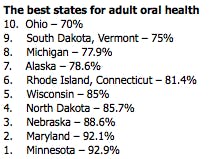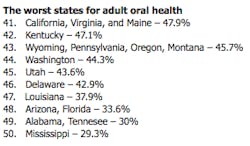States with the best (and worst) adult oral health care
October 8, 2013
We’ve seen a push lately from the American Dental Association to raise awareness about the importance of our oral health through education and to teach prevention to our children. An example of such is the recent "2min2x" campaignby the Ad Council and the Partnership for Healthy Mouths, Healthy Lives, which encouraged kids to brush twice a day for two minutes, using interactive and fun tools that kids might be interested in. Associations from the ADA to the ADHA agree that prevention is very important in attaining premium oral health, but it targets children and leaves out those who’ve passed the stage of prevention.
INFOGRAPHIC: In search of dental care
Which brings us to the need to address older adults, their health, and access to care. The reasons older adults are suffering are complex, says OHA.
Underlying causes of poor oral health
As the report explains, „Limited access to dental insurance, affordable dental services, community water fluoridation, and programs that support oral health prevention and education for older Americans are significant factors that contribute to edentulism among older Americans, particularly the most vulnerable.“
Why the dental industry wants exemption from Obamacare
It’s widely known that oral conditions disproportionately affect those in lower socioeconomic brackets, racial and ethnic minorities, and obviously those with limited or no access to dental insurance, but the problem also disproportionately affects older adults with disabilities, those who are homebound, and those who are institutionalized.
State-by-state analysis
Several factors were analyzed within each state to determine those that offer the best – and worst – care to their aging populations. They are: access to adult Medicaid dental benefits, edentulism, current state of oral health plan with a goal promoting older adult oral health, dental health professional shortage areas (HPSA), and community water fluoridation. You can see exactly how the scores were totaled in the report.
States with a score of 90% or above have what’s considered "excellent" oral health care for older adults. 70-89.9% is "good," 50-69.9% is "fair," and anything below 50 is "poor." Two states have excellent care, while 17 ended up with poor scores.
Florida improving access to care, says AHCA
Recommendations
The report closes with recommendations to improve the states‘ scores, which involve payment options, state healthcare plans, education, water fluoridation, and improving the primary healthcare workforce.
For an overview of all 50 states, read the full report "State of Decay: Are Older Americans Coming of Age Without Oral Healthcare?"




